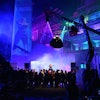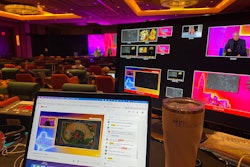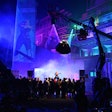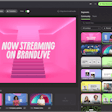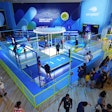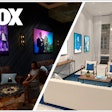
When the National Bar Association (NBA—but not that kind) was making plans for its 96th annual convention, taking place July 23-27, 2021, the team quickly realized that canceling was out of the question—even if that meant switching to virtual for the second year in a row.
“They had so much rich content to share with the community, annual voting to conduct and continuing education to provide,” said Renee Radabaugh, president and CEO of Paragon Events, the Florida-based event firm that produced the convention. “For associations, these chances to connect and engage are vital, so canceling was not an option—but it is ever more critical that the programming put in place be impactful, practical and cohesive.”
The NBA tapped Paragon Events—along with virtual platform vFairs and audiovisual partner Rescue Events—to help support the planning committee and create a more elevated and cohesive virtual experience. “We brought to the table the technical know-how of virtual platforms, and an ability to streamline the planning process and execution to help NBA focus on their voice and their message,” Radabaugh explained.
And that execution was anything but simple, with a virtual career fair component, an exhibition floor, networking experiences, various entertainment events, an award gala and a whopping 150 education sessions—including one with Vice President Kamala Harris—over a five-day period. Paragon Events managed all aspects of the event’s production, from vetting platforms and speaker management to sponsorship booth design and set-up, ultimately building, managing and executing the event over the course of several months.  "Our virtual platform partners, vFairs, was incredible with supporting the client’s technical requests and last-minute changes," said Radabaugh. "With their team we were able to design a beautiful and interactive virtual environment for attendees."Screenshot: Courtesy of Paragon Events
"Our virtual platform partners, vFairs, was incredible with supporting the client’s technical requests and last-minute changes," said Radabaugh. "With their team we were able to design a beautiful and interactive virtual environment for attendees."Screenshot: Courtesy of Paragon Events
We chatted with Radabaugh about some logistics and lessons learned from the ambitious undertaking. Here are her top tips that all virtual event producers can learn from.
1. Understand how the timeline has changed with the shift to virtual.
“The biggest challenge we typically encounter with virtual planning is a lack of a sense of urgency,” noted Radabaugh. “This challenge isn’t unique to this group, but with virtual programs in general—understanding the importance of the platform timeline is essential.”
Radabaugh noted that virtual platforms can typically require prerecorded presentations at least 30 days in advance, which allows them to be preloaded and tested. “Testing is imperative for timing and logistical prep, and presenters don’t always have their material ready that early in the planning process. Speakers also don’t always realize that a deadline is real and view it as more of a suggestion than a requirement.”
Many speakers are accustomed to presenting live and being able to tweak their presentations right before going on stage, Radabaugh added. “When presenters are changing their sessions last minute and we don’t have time to test in advance, this can cause delays and software glitches, which can diminish the audience experience.”
The best way for planners to prepare for these challenges, she said, is to have a robust staff. “Watch on the front end from an audience view, have multiple people managing the backend of sessions, have bumpers and hold slides ready, test and retest your Wi-Fi and technology.”
Of course, this type of prep time isn’t always possible. For Vice President Harris’ speech at the NBA event, for example, the session had a 12-hour turnaround time and was being livestreamed from the White House. “So we had all hands on deck: the AV company, the platform team, the client team, the White House advance staff and, of course, six Paragon Events staff managing screens, bumpers and slides,” Radabaugh explained. “Luckily, we were working with an experienced speaker, but the pressure was on our team to make sure the session flowed smoothly and without technical issues.” Vice President Harris’ presentation was viewed by over 500 people live, Radabaugh noted, along with another 15,000 when posted on the White House YouTube page. “VP Harris also shared mentions of our client and her presentation on her social media,” she said. “This is the success we all enjoy the most—a client being celebrated for the hard work we provide behind the scenes. Our work is our signature, but remember it is also our client’s signature.”Screenshot: Courtesy of Paragon Events
Vice President Harris’ presentation was viewed by over 500 people live, Radabaugh noted, along with another 15,000 when posted on the White House YouTube page. “VP Harris also shared mentions of our client and her presentation on her social media,” she said. “This is the success we all enjoy the most—a client being celebrated for the hard work we provide behind the scenes. Our work is our signature, but remember it is also our client’s signature.”Screenshot: Courtesy of Paragon Events
2. Tech rehearsals are crucial.
“Teaching presenters and speakers the various technical aspects of participating in [a virtual] event takes more forethought and preparation,” noted Radabaugh. “With virtual events, you have to make sure that your speakers are not only comfortable presenting the content but also with the production aspect: Have they tested their equipment? Do they have the right lighting? Is their Wi-Fi able to support the presentation—is it strong enough and robust enough? Are they familiar with how to start/stop their camera and mute/unmute? Those are all aspects that we would typically control in an in-person event so that the speaker only has to show up and speak.”
Radabaugh added that a virtual run of show is actually less forgiving than an in-person one. “You don’t have the same ‘tricks’ that you can lean on to fill technical gaps. Where you might let music play for an extra 10 seconds while mic-ing up a speaker or dealing with an AV issue when you are live, you don’t have that same luxury when virtual. Those technical issues are the show,” she explained. “Preparation is absolutely key. There is no time to change your deck, update a slide on the fly, run to the bathroom last minute, go on a tangent, and run over on your time or start your Q&A early. Virtual is ‘3, 2, 1, action’—and you are on.” In addition to over 150 education sessions, the virtual convention featured a career fair component, entertainment experiences and an award gala.Screenshot: Courtesy of Paragon Events
In addition to over 150 education sessions, the virtual convention featured a career fair component, entertainment experiences and an award gala.Screenshot: Courtesy of Paragon Events
3. Coach your speakers on best practices for virtual presentations.
For NBA speakers who were less comfortable or experienced presenting virtually, the Paragon Events team offered speaker training sessions—ultimately giving group and one-on-one trainings to over 100 presenters. Radabaugh said this type of training can help speakers understand the shifts needed to create a compelling virtual presentation.
“After all, you can’t look in the eyes of your audience or receive their energy. You lose the emotional connection,” she pointed out. “Some people in virtual environments treat the presentation like a normal Zoom [meeting], when in fact they should treat it the same as they would live—stand up, speak directly and intently to the audience, and be enthusiastic! You have to provide the audience your energy, instead of vice versa.”
And be ready to work around your speakers’ schedules, Radabaugh added. “Since much of the group were attorneys or legal professionals, the work day was their day to service their clients. We had to manage update meetings after hours, and much of the programming was on the weekend.” The National Bar Association is the country's oldest and largest national association of predominately African-American lawyers, judges, educators and law students.Screenshot: Courtesy of Paragon Events
The National Bar Association is the country's oldest and largest national association of predominately African-American lawyers, judges, educators and law students.Screenshot: Courtesy of Paragon Events
4. Lean into your audience’s different learning styles.
With virtual, noted Radabaugh, “you open the event up to a larger audience who may have different learning styles or who have gotten comfortable ‘learning behind a screen’ in the comfort of their office or home. I think there is also more of an open door for participants that don’t have the budget to travel to an event, pay for a hotel, etc.”
And that’s a good thing, she said—even if it requires some out-of-the-box thinking by everyone involved. “Servicing multiple audiences can generate more attendance and greater exposure for the organization. The challenge is getting sponsors and exhibitors to think creatively while enhancing opportunities for engagement and participation.”
